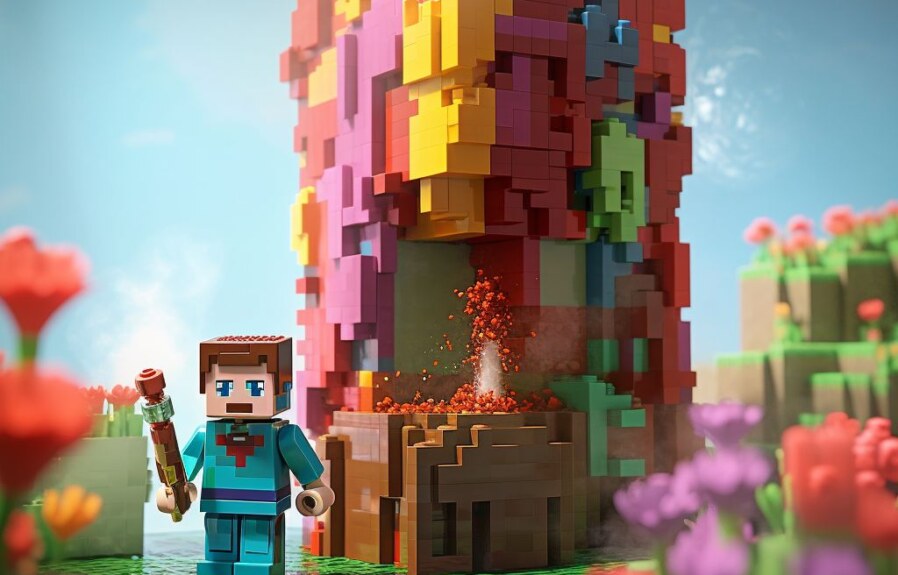If you’re an avid Minecraft player, you know how important transportation can be in the game. Whether you’re building a massive fortress or trying to explore new areas, finding efficient ways to get around can make all the difference. One unique way to do this is by constructing a water elevator. These nifty devices can easily transport you between different levels of your Minecraft world, and are surprisingly easy to make. In this article, we’ll take a look at the step-by-step process of creating a water elevator in Minecraft, so you can add this useful tool to your arsenal of Minecraft creations.
1. Introduction to Water Elevator in Minecraft: What is It?
In Minecraft, a water elevator is a vertical system of water blocks that can transport players and mobs safely and quickly from one level to another. This mechanism is quite useful in Minecraft as it saves the player time and effort while also adding an extra element of convenience to their gameplay.
Water elevators can be built using very few resources, which makes them a great addition to any player’s setup. They are also easy to customize and upgrade, making them both practical and enjoyable to create.
Overall, water elevators are an essential part of the Minecraft gaming experience and are worth learning how to create. In the following sections, we will explore the materials and tools required for building a water elevator, step-by-step instructions on how to build one, some extra features you can add to your water elevator, and common mistakes to avoid when building one.
2. Materials and Tools Required to Build a Water Elevator
In this section, we will discuss the necessary materials and tools you will need to build a water elevator in Minecraft.
Materials
To build a water elevator, you will need the following materials:
- Water source: The most crucial material to create a water elevator is a water source block. You can obtain it from oceans, rivers, or lakes. Ensure that you have a water bucket to pick up the block.
- Building block: The building block should be something that water can flow through. You can use signs, soul sand, or magma blocks as per your preference.
- Slabs: You will need slabs to create the water pathway for the elevator.
- Doors: You can use doors to create an entrance for your elevator at the end of the water pathway.
Tools
In addition to materials, the following tools will also be required to construct a water elevator:
- Bucket: You will need a bucket to pick up water blocks and move them around.
- Pickaxe: You will need a pickaxe to gather building blocks like soul sand, magma blocks, or signs.
- Shovel: A shovel will be required to dig through terrain to get to your water source.
It is essential to ensure that you have all the necessary materials and tools before starting your water elevator project. Remember to have your inventory organized, so you don’t lose any essential items during the building process. In the next section, we will provide you with a step-by-step guide to constructing a water elevator in Minecraft.
3. Step-by-Step Guide to Building a Water Elevator: Tips and Tricks
Now that we’ve covered the materials and tools required to build a water elevator in Minecraft, it’s time to dive into the step-by-step guide on building it. Keep in mind, building a water elevator requires patience, time, and precision to get it right. Follow these tips and tricks to make it smoother:
Step 1
Start by selecting a location for your elevator. You can build your elevator anywhere that’s convenient for you, but remember to build it in a waterproof area. If you’re a beginner, it’s recommended to build your elevator near your base for quick access.
Step 2
Once you’ve selected the location, start digging a hole that’s two blocks wide and at least five blocks deep into the ground. Next, dig a water source block into the bottom of the hole. You can do this by either placing one bucket of water or breaking a water block and letting it flow into the hole.
Step 3
Place a signboard in the middle of the hole, two blocks up from the water source block. This signboard will separate the water source block into two parts, and create a water column that will function as the elevator.
Step 4
After placing the signboard, remove the block above the water source, so water can flow easily through the signboard. Then, place blocks on either side of the hole, one block above the signboard. This will create a water flow that pulls you up and down the elevator.
Step 5
Lastly, add a pressure plate or button to activate and deactivate the elevator. You can even build a redstone mechanism to automatically activate the water elevator when you step on the pressure plate.
These steps will help you build a basic water elevator. However, if you want to increase or reduce the speed of the water elevator, you can adjust the distance between the signboard and the blocks encasing the elevator. Additionally, you can add glass blocks or different colored blocks to add aesthetics to your water elevator.
Follow these tips and tricks to build a functional water elevator in Minecraft and take your gameplay to the next level.
4. Extra Features and Upgrades for Water Elevator in Minecraft: Redstone and More
A water elevator in Minecraft is an excellent way to transport players or mobs vertically up or down. However, with some additional features and upgrades, it can become even more convenient and efficient. Here are some ideas for making your water elevator more cutting edge and adding extra functionality.
1. Redstone Activation:
Players could adjust their water elevator to become activated with redstone. They could use levers, buttons, and pressure plates to create an automatic elevator that could be activated with a simple press. While using redstone, players might use tripwires to alert them when mobs or players enter the elevator area, which could be helpful in detecting intruders or notifying when players can use the elevator.
2. Multiple Floors:
Another great feature that could be added to a water elevator is multiple floors. This is particularly useful in Minecraft buildings that have many stories. Players could have a button or lever next to their water elevator, and when they press it, they could select the floor they want to go to. This type of water elevator is more complicated to build, but it adds a lot of functionality to a Minecraft building.
3. Lighting:
Lighting can be an essential feature when building a water elevator in dark or intricate spaces. Players could install lighting elements inside their water elevator to add illumination while in use. This feature could enhance the aesthetic appeal of the elevator and prevent accidents in poorly lit environments.
Adding features and upgrades to a Minecraft water elevator enhances its functionality and aesthetic value. While these additional features might seem elaborate, they’re relatively easy to implement and require only a little bit of effort. Incorporating redstone activation, multiple floors, and lighting are excellent ways to improve your Minecraft water elevator and enhance your gameplay experience.
5. Common Mistakes to Avoid When Building a Water Elevator in Minecraft
Building a water elevator in Minecraft is a fun and exciting task. However, it can also be a bit tricky to get it right. There are some common mistakes that players make when building water elevators, which can lead to frustration and wasted resources. In this section, we’ll discuss some of these mistakes and how to avoid them.
1. Using the Wrong Block Types
One of the most common mistakes players make when building water elevators is using the wrong block types. It’s important to note that not all blocks can hold water. For example, if you use a block such as dirt or gravel, the water will not stay in place, and your water elevator won’t work as intended. Blocks like glass, ice, and slabs won’t work either.
Therefore, when building a water elevator, always make sure to use blocks that can hold water, such as building blocks like stone, cobblestone, or wood planks. These types of blocks allow water to be contained and flow through them, making them ideal for creating water elevators.
2. Inadequate Space or Insufficient Height
Another common mistake players make when building water elevators is not giving them enough space or insufficient height. To ensure that the water elevator works as intended, you’ll need to ensure that you have enough space and height for the elevator to operate correctly.
If you don’t give your water elevator enough height, it won’t be able to lift you up to your desired destination. Similarly, if you don’t give it enough space, you might accidentally swim underneath the elevator and get stuck.
Therefore, when building your water elevator, make sure to double-check that you have enough height and space for it to function correctly.
3. Lacking Redstone Support
The last common mistake players make when building water elevators is not adding redstone support. Redstone is a critical component in Minecraft that players can use to create complex mechanisms, including those that power water elevators.
If you forget to add redstone support, your water elevator won’t work correctly, leaving you stranded or forced to take the stairs. To avoid this mistake, make sure to add redstone support to your water elevator. You can use redstone-powered mechanisms to turn the water on or off, control the elevator’s speed, and even add additional features to make your water elevator more functional and aesthetically pleasing.
In conclusion, building a water elevator in Minecraft can be a bit complicated, but it’s ultimately a fun and rewarding experience. Avoiding common mistakes can help ensure that your water elevator functions correctly and provides you with a unique and exciting way to travel through your Minecraft world.
People Also Ask
What is a water elevator in Minecraft?
A water elevator is a vertical transportation method in Minecraft that utilizes water to move players or mobs vertically.
How do you make a water elevator in Minecraft?
To make a water elevator in Minecraft, build a tower of soul sand or magma blocks and place water source blocks on top of each block, allowing them to flow down. Then, enter the water flow to move vertically.
Can you use boats in a water elevator in Minecraft?
Yes, boats can be used in a water elevator in Minecraft by placing them on the water current and right-clicking to sit inside.
How do you make a soul sand elevator in Minecraft?
To make a soul sand elevator in Minecraft, create a tower of soul sand and place water source blocks on top of each block, allowing them to flow down. Enter the water flow to move vertically.
Can you use a piston in a water elevator in Minecraft?
Yes, a piston can be used in a water elevator in Minecraft to control the water flow and stop it from flowing down. It’s useful for creating water elevators with multiple floors.
Conclusion
Water elevators in Minecraft are easy and fun to make. You can use soul sand or magma blocks to create the vertical transportation and boats or pistons to help control the flow. Water elevators are handy for moving players or mobs vertically, especially in tall structures. Experiment with different designs and have fun!



